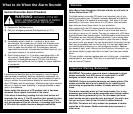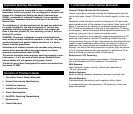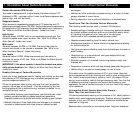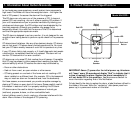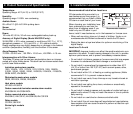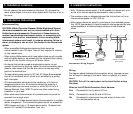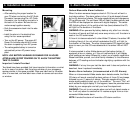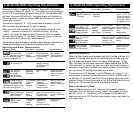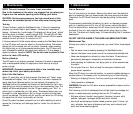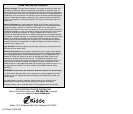
7. Maintenance
NOTE: This unit is sealed. The cover is not removable.
Due to the loudness of the alarm, we suggest that you place your
fingers over the sounder opening while testing your alarm.
CAUTION: Continuous exposure to the high sound level of this
alarm over an extended period of time may cause hearing loss.
Testing
To test the alarm, press the Test/Reset button. If the unit is operating
properly
, you should hear 4 quick beeps – followed by 5 seconds of
silence – followed by 4 quick beeps. The display will show three “eights”
and then show a number – usually around 200). The red LED will flash
along with the beeps and the amber LED will illuminate. Within several
seconds the unit will return to monitor for CO.
If interconnected to Kidde smoke alarms, pressing the Test/Reset button
on the CO alarm will have no effect on the smoke alarms. The smoke
alarms will not be tested and will not alarm. However, when pressing
the Test button on an interconnected smoke alarm, the CO alarm will
emit a Smoke/Fire audible and visual alarm pattern of 3 long beeps, 1
second of silence, repeated. NOTE: You do not need to press the Test
button to take a CO r
eading.
Battery Backup
This CO alarm is not battery operated. However
, the alarm is equipped
with a rechargeable battery to supply short term back-up during a
power outage.
IMPORTANT: Constant exposures to high or low humidity may
reduce the life of your battery and alarm.
End of Life Notification
Seven (7) years after unit is first powered, this alarm will “beep” every
30 seconds and display "End" to indicate that it is time to r
eplace the
alar
m (see Alarm Removal section for instructions). By pressing the
Test/Reset button the audible notification will be silenced for up to two
days giving you time to replace the unit at a more convenient time. The
display will alternate between the the CO ppm reading and "End" to
remind you to replace the unit right away. This silence feature can only
be used for a few days before it will no longer function and the beep
cannot be silenced. The alarm will still monitor and alarm for CO during
this period but all other functionality will be lost.
Once AC power has been removed from unit after reaching its end of
service life, the battery will discharge itself to render the unit safe for
disposal.
7. Maintenance
Alarm Removal
Turn off the power to the alarm. Remove the alarm from the electrical
box by unscrewing the four screws under the cover securing the alarm.
Disconnect the AC Quick-Connector harness by pulling the connector
apart.
To permanently deactivate the battery for return or disposal purposes
prior to it reaching end of life: turn off AC power, remove the alarm
from the electrical box, disconnect the AC wires, puncture the label on
the back of the unit, and press the small switch using a pen or other
thin tool. The alarm will rapidly beep 10 times indicating that it has been
deactivated.
DO NOT USE THE ALARM IF THE LABEL HAS BEEN PUNCTURED!
Maintenance Tips
To keep your alarm in good working or
der
, you must follow these simple
steps:
• Test the alarm once a week by pressing the Test/Reset button.
• Vacuum the alarm cover once a month to remove accumulated dust.
• Never use detergents or solvents to clean the alarm. Chemicals can
permanently damage or temporarily contaminate the sensor.
• Avoid spraying air fresheners, hair spray, paint or other aerosols near
the alarm.
• Do not paint the unit. Paint will seal the vents and interfere with
proper sensor operation.
Move the CO alarm to a remote location, to prevent possible damage or
contamination of the sensor, prior to performing any of the following:
• Staining or stripping floors or furniture, painting or wall-papering
• Using aerosols or adhesives
WARNING: Reinstall the CO alarm as soon as possible to assure continu-
ous pr
otection.
The following is a list of substances that at high levels can damage the
sensor or cause temporary r
eadings that are not CO readings:
• Ethylene, ethanol, alcohol, iso-propanol, benzene, toluene, ethyl
acetate, hydrogen, hydrogen sulfide and sulfur dioxide.
• Also most aerosol sprays, alcohol based products, paint, thinner, sol-
vent, adhesive, hair spray, aftershave, perfume, auto exhaust (cold
start) and some cleaning agents.




